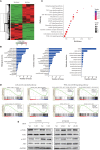CACNA2D3 Enhances the Chemosensitivity of Esophageal Squamous Cell Carcinoma to Cisplatin via Inducing Ca2+-Mediated Apoptosis and Suppressing PI3K/Akt Pathways
- PMID: 31001468
- PMCID: PMC6454090
- DOI: 10.3389/fonc.2019.00185
CACNA2D3 Enhances the Chemosensitivity of Esophageal Squamous Cell Carcinoma to Cisplatin via Inducing Ca2+-Mediated Apoptosis and Suppressing PI3K/Akt Pathways
Abstract
Resistance to platinum-based combination chemotherapy is the main cause of poor prognosis in patients with advanced esophageal squamous cell carcinoma (ESCC). Previously, we showed that CACNA2D3 (voltage-dependent subunit alpha 2 delta 3 of a calcium channel complex) was significantly downregulated and functioned as a tumor suppressor in ESCC, but its role in the chemosensitivity of ESCC to cisplatin remained unknown. Here, we found that the expression of CACNA2D3 was significantly associated with poor platinum response in ESCC patients from the Gene Expression Omnibus database. Overexpression of CACNA2D3 increased sensitivity to cisplatin in ESCC in vitro, whereas knockdown of CACNA2D3 increased cisplatin resistance. CACNA2D3 promoted cisplatin-induced apoptosis by modulating intracellular Ca2+ stores. In vivo experiments further showed that overexpression of CACNA2D3 enhanced cisplatin anti-tumor effects in a xenograft mouse model. CACNA2D3 overexpression also resulted in the attenuation of PI3K and Akt phosphorylation. Treatment with the PI3K/Akt inhibitor LY294002 restored the chemosensitivity of CACAN2D3-knockdown cells to cisplatin. In conclusion, the results of the current study indicate that CACAN2D3 enhances the chemosensitivity of ESCC to cisplatin via inducing Ca2+-mediated apoptosis and suppressing PI3K/Akt pathways. Therefore, regulating the expression of CACNA2D3 is a potential new strategy to increase the efficacy of cisplatin in ESCC patients.
Keywords: CACNA2D3; ESCC; LY294002; chemosensitivity; voltage-gated calcium channel.
Figures






Similar articles
-
ALC1 knockdown enhances cisplatin cytotoxicity of esophageal squamous cell carcinoma cells by inhibition of glycolysis through PI3K/Akt pathway.Life Sci. 2019 Sep 1;232:116679. doi: 10.1016/j.lfs.2019.116679. Epub 2019 Jul 21. Life Sci. 2019. PMID: 31340168
-
eIF4E promotes tumorigenesis and modulates chemosensitivity to cisplatin in esophageal squamous cell carcinoma.Oncotarget. 2016 Oct 11;7(41):66851-66864. doi: 10.18632/oncotarget.11694. Oncotarget. 2016. PMID: 27588477 Free PMC article.
-
Down-regulation of Rictor enhances cell sensitivity to PI3K inhibitor LY294002 by blocking mTORC2-medicated phosphorylation of Akt/PRAS40 in esophageal squamous cell carcinoma.Biomed Pharmacother. 2018 Oct;106:1348-1356. doi: 10.1016/j.biopha.2018.07.075. Epub 2018 Jul 23. Biomed Pharmacother. 2018. PMID: 30119206
-
Investigation of tumor suppressing function of CACNA2D3 in esophageal squamous cell carcinoma.PLoS One. 2013;8(4):e60027. doi: 10.1371/journal.pone.0060027. Epub 2013 Apr 3. PLoS One. 2013. PMID: 23560067 Free PMC article.
-
miR-145 sensitizes esophageal squamous cell carcinoma to cisplatin through directly inhibiting PI3K/AKT signaling pathway.Cancer Cell Int. 2019 Sep 30;19:250. doi: 10.1186/s12935-019-0943-6. eCollection 2019. Cancer Cell Int. 2019. PMID: 31582906 Free PMC article.
Cited by
-
Roles of Ion and Water Channels in the Cell Death and Survival of Upper Gastrointestinal Tract Cancers.Front Cell Dev Biol. 2021 Mar 11;9:616933. doi: 10.3389/fcell.2021.616933. eCollection 2021. Front Cell Dev Biol. 2021. PMID: 33777930 Free PMC article. Review.
-
Advances and challenges in the treatment of esophageal cancer.Acta Pharm Sin B. 2021 Nov;11(11):3379-3392. doi: 10.1016/j.apsb.2021.03.008. Epub 2021 Mar 9. Acta Pharm Sin B. 2021. PMID: 34900524 Free PMC article. Review.
-
Guhong Injection Protects Against Apoptosis in Cerebral Ischemia by Maintaining Cerebral Microvasculature and Mitochondrial Integrity Through the PI3K/AKT Pathway.Front Pharmacol. 2021 May 13;12:650983. doi: 10.3389/fphar.2021.650983. eCollection 2021. Front Pharmacol. 2021. PMID: 34054531 Free PMC article.
-
Lipid-soluble polyphenols from sweet potato exert antitumor activity and enhance chemosensitivity in breast cancer.J Clin Biochem Nutr. 2021 May;68(3):193-200. doi: 10.3164/jcbn.20-73. Epub 2021 Jan 16. J Clin Biochem Nutr. 2021. PMID: 34025021 Free PMC article.
-
PI3K/Akt/mTOR Signaling Pathway: Role in Esophageal Squamous Cell Carcinoma, Regulatory Mechanisms and Opportunities for Targeted Therapy.Front Oncol. 2022 Mar 22;12:852383. doi: 10.3389/fonc.2022.852383. eCollection 2022. Front Oncol. 2022. PMID: 35392233 Free PMC article. Review.
References
-
- Ando N, Iizuka T, Ide H, Ishida K, Shinoda M, Nishimaki T, et al. . Surgery plus chemotherapy compared with surgery alone for localized squamous cell carcinoma of the thoracic esophagus: a Japan clinical oncology group study–JCOG9204. J Clin Oncol. (2003) 21:4592–6. 10.1200/JCO.2003.12.095 - DOI - PubMed
LinkOut - more resources
Full Text Sources
Miscellaneous

